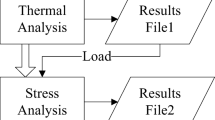Abstract
The Gaussian laser mode can be converted into a hollow-ring laser mode through beam conversion system, realizing the conversion of circular and solid spot into a hollow-ring spot, which changes the energy distribution form of the laser spot. In order to study the effects of the Gaussian and hollow-ring laser modes on temperature and stress fields in cladding layers, the numerical simulation and experimental investigation were performed. The results showed that molten pool experienced once temperature peak and generated sharp temperature change under the Gaussian laser, while the molten pool experienced twice temperature peaks and temperature changed relatively gentle when using hollow-ring laser. Comparing with the Gaussian laser, the maximum temperature gradient along the depth of cladding layer decreased by 72.3% from 1.79 × 106 to 4.95 × 105 ℃/m, and the maximum residual stress decreased from 272 to 251 MPa under hollow-ring laser. Meanwhile, the simulation results were validated by experiments with the same process. Furthermore, the sample microstructure was studied from the experiment. The microstructure was finer and more uniform using hollow-ring laser. This paper can provide guidance and advantage for laser cladding and direct metal deposition based on the hollow-ring mode and expand the application of laser field.















Similar content being viewed by others
References
Weng F, Chen CZ, Yu HJ (2014) Research status of laser cladding on titanium and its alloys: a review. Mater Design 58:412–425
Zeng C, Tian W, Liao WH, Hua L (2016) Microstructure and porosity evaluation in laser-cladding deposited Ni-based coatings. Surf Coat Technol 294:122–30
Yang J, Chen J, Yang HO, Lin X, Huang WD (2004) Experimental study on residual stress distribution of laser rapid forming process. Rare Met Mater Eng 33(12):1304–1307
Tseng WC, Aoh JN (2013) Simulation study on laser cladding on preplaced powder layer with a tailored laser heat source. Opt Laser Technol 48:141–152
Sun ST, Fu HG, Chen SY, Ping XL, Wang KM, Guo XY, Lin J, Lei YP (2019) A numerical-experimental investigation of heat distribution, stress field and crack susceptibility in Ni60A coatings. Opt Laser Technol 117:175–185
Wang H (2014) Effect of process parameters on residual stress distribution during direct laser metal deposition. Adv Mater Res 989(994):49–54
Heigel JC, Michaleris P, Reutzel EW (2015) Thermo-mechanical model development and validation of directed energy deposition additive manufacturing of Ti-6Al-4V. Addit Manuf 5:9–19
Yan ZR, Liu WW, Tang ZJ, Liu XY (2019) Effect of thermal characteristics on distortion in laser cladding of AISI 316L. J Manuf Process 44:309–318
Krzyzanowski M, Bajda S, Liu YJ, Triantaphyllou A, Rainforth WM, Glendenning M (2016) 3D analysis of thermal and stress evolution during laser cladding of bioactive glass coatings. J Mech Behav Biomed Mater 59:404–417
Wang T, Qin LC, Liu JQ (2019) Parameter analysis of thermal behavior during laser melting of Ti-6Al-4V alloy powder. Int J Adv Manuf Techol 104(5–8):2875–2885
Liu HM, Qin XP, Wu MW (2019) Numerical simulation of thermal and stress field of single track cladding in wide-beam laser cladding. Int J Adv Manuf Techol 104(9–12):3959–3976
Shi SH, Fu GY, Wang AJ, Zhang Y, Zhu PF, Hu J (2006) Internal powder feeding technology and nozzle through a hollow laser beam in laser processing forming manufacturing. Chinses Patent CN200610116413,2006-09-22
Shi GL, Shi SH, Wu SH (2010) Research on effective utilization rate of power in inside-laser coaxial powder feeding laser cladding and rapid prototyping process. Hot Working Technol 7:152–161
Shi JJ (2019) Mechanism study of non-supportive overhang part by hollow laser cladding forming. Soochow University, Su zhou
Liu Y, Zhang J, Pang ZC (2018) Numerical and experimental investigation into the subsequent thermal cycling during selective laser melting of multi-layer 316 L stainless steel. Opt Laser Technol 98:23–32
Hussein A, Hao L, Yan C, Everson R (2013) Finite element simulation of temperature and stress in single layers built without-support in selective laser melting. Mate Des 52:638–647
Mohammadpour M, Yazdian N, Yang G, Wang HP, Carlson B, Kovacevic R (2018) Effect of dual laser beam on dissimilar welding-brazing of aluminum to galvanized steel. Opt Laser Technol 98:214–228
Santhanakrishnan S, Kong F, Kovacevic R (2011) An experimentally based thermo-kinetic hardening model for high power direct diode laser cladding. J Mater Process Technol 211(7):1247–1259
Capello E, Castrelnuovo M, Previtali B, Vedali M (2007) Surface treatment of welded duplex stainless steels by diode laser. J Laser Appl 19(3):133–140
Farahmand P, Kovacevic R (2014) An experimental–numerical investigation of heat distribution and stress field in single-and multi-track laser cladding by a high-power direct diode laser. Opt Laser Technol 63:154–168
Gao WY, Zhao SS, Wang YB, Liu FL, Zhou CY, Lin XC (2014) Effect of re-melting on the cladding coating of Fe-based composite powder. Mater Des 64(9):490–496
Jiang W, Yahiaoui K, Hall FR (2005) Finite element predictions of temperature distributions in a multi pass welded piping branch junction. J Pressure Vessel 127(1):7–12
Funding
The work was financially supported by the Sci-Tech Plan Project of Suzhou municipal of China through grant no. SYC2022143 and the National Key Research Program of China through grant no.2016YFB1100300.
Author information
Authors and Affiliations
Corresponding authors
Ethics declarations
Ethics approval
Not applicable.
Consent to participate
Not applicable.
Consent for publication
Not applicable.
Conflict of interest
The authors declare no competing interests.
Additional information
Publisher's note
Springer Nature remains neutral with regard to jurisdictional claims in published maps and institutional affiliations.
Rights and permissions
Springer Nature or its licensor (e.g. a society or other partner) holds exclusive rights to this article under a publishing agreement with the author(s) or other rightsholder(s); author self-archiving of the accepted manuscript version of this article is solely governed by the terms of such publishing agreement and applicable law.
About this article
Cite this article
Zhu, G., Li, G., Wang, L. et al. Contrastive analysis of temperature and stress field distribution in cladding layer by the Gaussian and hollow-ring laser modes. Int J Adv Manuf Technol 127, 5599–5609 (2023). https://doi.org/10.1007/s00170-023-11809-z
Received:
Accepted:
Published:
Issue Date:
DOI: https://doi.org/10.1007/s00170-023-11809-z



